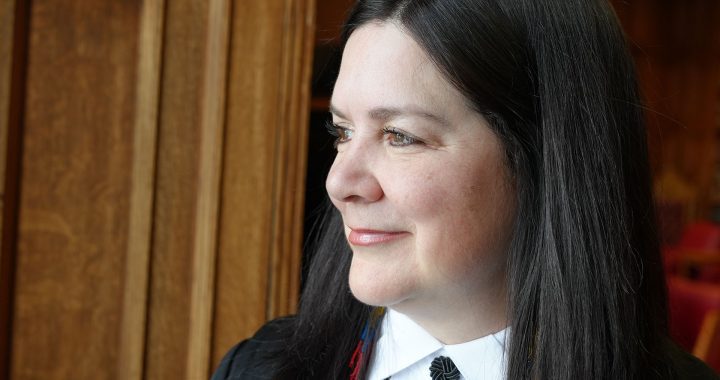The RCMP says it will start rolling out body-worn cameras for front line staff across Canada next week, something it hopes will help improve relationships with Indigenous people and communities when it comes to policing.
“It’s, I think, a positive initiative that could help build trust and transparency between the police and the Indigenous communities we serve,” said Taunya Goguen, director general of the body-worn camera program.
The rollout will begin Nov. 18. Over the next nine months, approximately 1,000 frontline RCMP officers per month will begin using body-worn cameras. The footage will be uploaded and stored on a secure “digital evidence management system.”
Goguen said 90 per cent of frontline members will be using body-worn cameras by November of next year. Full deployment will be complete in the next 12 to 18 months.
“The objectives of the body-worn camera project are strengthening transparency, accountability and public trust, resolving public complaints more quickly, improving interactions between the public and police, and also improved evidence gathering,” she said.
Goguen said frontline staff will be trained to turn on their cameras prior to arriving on a call as soon as they take their seatbelts.
She said the cameras won’t be used for 24-hour recordings, nor will they be used for surveillance, during intimate searches or where there are high expectations of privacy such as a hospital or in a washroom, unless there are exigent circumstances.
Officers will only have access to their own videos and cannot delete video evidence. Goguen said the retention of a video will depend on the type of incident that occurred and existing legislation, which can range from 30 days to two years or longer.
Goguen said body-worn camera footage will only be released publicly on an “exceptional basis” and “only when the public interest outweighs the invasion of privacy of an individual.”
The Federal government committed $238.5 million towards body cameras over six years in 2020. The program will cost $50 million in annual operational costs.
Body cameras have already been field-tested in select communities across Canada.
Body cameras not ‘fool-proof’ says professor
At least ten Indigenous people have died in recent months following interactions with law enforcement. The latest is the shooting death of Joshua Papigatuk in Salluit, Nunavik on Nov. 4. His twin brother Garnet was injured.
But in recent memory, the incidents go back to late August and early September.
On Sept. 8, Steven “Iggy” Dedam, 34, a member of the Elsipogtog First Nation, was shot and killed after two RCMP officers responded to a wellness check.
Michael Boudreau, a professor of criminology and criminal justice at St. Thomas University in New Brunswick, said the absence of body camera footage will make the investigation into Dedam’s death “very difficult.”
“In that sense, (body-worn cameras) are positive, because it is another tool to hold the police accountable,” he said.
“All we have are the two responding officers accounts, and that’s it. Because the individual who was killed cannot testify, so we have no other corroborating evidence.”
Read More:
RCMP says body-worn cameras going ahead after Nunavut pilot project
Shawn King, vice president of the Criminal Trial Lawyers Association, called the cameras “a great idea.”
“These body cams, I think, are going to make things easier or more streamlined for us,” he said. “The more footage you can get of what’s happening, the more you can either figure out what’s gone on or prove what’s what hasn’t actually happened.”
King noted the presence of cameras may cause the RCMP to be more cautious in their interactions with Indigenous people.
“I think that’ll start holding people more accountable as to as to what’s going on and the use of force will probably start dropping,” he said.
However, Boudreau said body-worn cameras aren’t “fool-proof.”
He said body cameras have limited ranges and that footage sometimes isn’t useful in court cases because its too grainy.
Boudreau also takes issue with the RCMP having control over the footage.
“If the RCMP (are) going to be the ultimate judge and jury about who gets to see this footage, that’s problematic,” he said.
Boudreau said body cameras are a “good start” to rebuilding trust with Indigenous communities, though he feels it’s not the only solution.
“I cannot speak for the Indigenous communities, but the level of mistrust that that I’ve been aware of within Indigenous communities, I think it’s going to take a lot more than just body worn cameras to improve that level of trust,” he said.
“Perhaps body worn cameras will help to improve that level of trust, if Indigenous peoples believe that the body worn cameras will hold the RCMP to account.”
Body cameras in the death of Jon Wells
Body worn cameras helped clarify the events surround the death of Jon Wells from Blood Tribe on Sept. 17 in Calgary. According to a statement from the City of Calgary, officers were called to a hotel after reports of a man causing a disturbance and refusing to leave.
“Officers attempted to de-escalate the situation; however, the man was not cooperative. A struggle ensued, resulting in one officer deploying a Taser. The man continued to be combative with officers, resulting in one officer deploying OC spray. The man was taken into custody and, shortly after, went into medical distress,” the release said.
It goes on to say despite attempts by emergency medical services personnel, Wells was declared dead at the scene.
But according to the Alberta Serious Incident Response Team, or ASIRT as it’s known, body worn cameras of the Calgary police told a very different story.
The report released shortly after the investigation began, said a lone officer approached Wells who was acting “erratically,” – searching for something on the ground that didn’t exist. After 30 seconds, he’s ordered to leave.
“The male is walking slowly towards the main door with his hands raised while stating to the officer, I don’t want to die. The lone officer tells the male to stop talking and continues to point the weapon at him.”
That’s when two more officers arrive on the scene, the release says, and Wells stops walking. The first officer holsters the Taser and attempts to grab Wells, the release adds.
“At no point during the interaction had the male been identified, nor was he ever told he was being detained or under arrest,” the release notes. “The male physically resists being grabbed and then is tackled by officer 2, who then punches the male in the head while both are on the ground.
“During this time, officers 1 and 3 deploy their (Tasers).”
Wells’ feet and hands were shackled, a spit hood was placed over his head and he was lying face down. A paramedic injects Wells with a sedative. He died shortly after.
The family and Blood Tribe are calling for an inquiry into his death.










